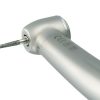اندودانتیکس در دندانپزشکی
مقدمه
اندودانتیکس یکی از شاخههای تخصصی دندانپزشکی است که به تشخیص، پیشگیری و درمان بیماریها و آسیبهای پالپ دندان و بافتهای پیرامون آن میپردازد. پالپ دندان شامل عصبها، عروق خونی و بافت همبند است که در قسمت مرکزی دندان قرار دارد. این رشته تخصصی با تمرکز بر حفظ دندانهای طبیعی و جلوگیری از استخراج آنها، نقش مهمی در بهبود کیفیت زندگی بیماران ایفا میکند.
اندودانتیکس در درجه اول به درمان ریشه دندان پرداخته و از این طریق تلاش میکند تا دندانهای طبیعی را حفظ کند. این رشته با استفاده از تکنیکها و تجهیزات پیشرفته، امکان درمان دندانهایی که در گذشته باید استخراج میشدند را فراهم کرده است. درمان موفق اندودانتیکس میتواند از نیاز به جایگزینی دندانهای از دست رفته با ایمپلنتها یا پروتزها جلوگیری کند.
تاریخچه
تاریخچه اندودانتیکس به دوران باستان بازمیگردد. مدارک باستانی نشان میدهند که مصریان باستان و تمدنهای اولیه دیگر تلاشهایی برای درمان مشکلات دندانی انجام میدادند. اما اندودانتیکس به عنوان یک رشته تخصصی در اوایل قرن بیستم شناخته شد.
در سالهای اخیر، پیشرفتهای تکنولوژیکی از جمله استفاده از میکروسکوپهای دندانپزشکی و تکنیکهای تصویربرداری پیشرفته مانند تصویربرداری سهبعدی با اشعه ایکس، بهبود چشمگیری در دقت و موفقیت درمانهای اندودانتیکس به همراه داشتهاند. این پیشرفتها همچنین به کاهش درد و نارضایتی بیماران در طول و بعد از درمان کمک کردهاند.
ساختار و عملکرد پالپ دندان
پالپ دندان، بخش نرم و مرکزی دندان است که شامل عصبها، عروق خونی و بافتهای همبند میباشد. این بافت نقش حیاتی در تغذیه دندان، حس درد و تحریک، و رشد و توسعه دندان ایفا میکند. پالپ درون کانالهای ریشه قرار دارد که از تاج دندان تا انتهای ریشه امتداد دارند.
پالپ دندان همچنین در تشخیص و واکنش به محرکهای حرارتی، شیمیایی و مکانیکی نقش دارد. این بافت قادر به احساس درد و انتقال آن به مغز است، که یکی از علائم اصلی مشکلات پالپ دندان است. پالپ همچنین به تولید عاج دندان (دنتین) کمک میکند که به حفاظت از دندان در برابر آسیبها و سایش کمک میکند.
بیماریها و آسیبهای پالپ دندان
بیماریها و آسیبهای پالپ دندان معمولاً ناشی از پوسیدگیهای عمیق، شکستگیهای دندان، یا آسیبهای فیزیکی میباشند. این مشکلات میتوانند منجر به التهاب پالپ (پالپیت) شوند که در صورت عدم درمان، به نکروز پالپ و انتشار عفونت به بافتهای پیرامونی منجر میشود.
پالپیت به دو نوع برگشتپذیر و برگشتناپذیر تقسیم میشود. پالپیت برگشتپذیر به وضعیتی اطلاق میشود که در آن پالپ هنوز قابلیت بهبود و ترمیم دارد. در پالپیت برگشتناپذیر، آسیب به پالپ غیرقابل ترمیم است و درمان ریشه ضروری میشود. علائم معمول پالپیت شامل درد شدید، حساسیت به حرارت و سرما، و تورم بافتهای پیرامون دندان است.
فرآیند درمان ریشه
درمان ریشه یا روت کانال تراپی، شامل حذف پالپ آسیبدیده، تمیز کردن و شکلدهی کانالهای ریشه، و پرکردن آنها با مواد مخصوص است. این فرآیند در چند مرحله انجام میشود:
- تشخیص و برنامهریزی: با استفاده از تصویربرداری رادیوگرافی و تستهای کلینیکی، وضعیت دندان و نیاز به درمان مشخص میشود. پزشک معاینه دقیق انجام داده و برنامه درمانی را براساس شرایط خاص هر بیمار تعیین میکند.
- دسترسی به کانال ریشه: از طریق ایجاد یک حفره کوچک در تاج دندان، دسترسی به پالپ و کانالهای ریشه فراهم میشود. این مرحله معمولاً تحت بیحسی موضعی انجام میشود تا بیمار دردی احساس نکند.
- حذف پالپ و تمیز کردن کانالها: پالپ آسیبدیده از کانالها خارج و با استفاده از ابزارهای خاص، کانالها تمیز و شکلدهی میشوند. این مرحله اهمیت زیادی دارد زیرا هر گونه باقیمانده پالپ یا باکتری میتواند باعث عفونت مجدد شود.
- پرکردن کانالها: کانالهای تمیز شده با مواد گوتاپرکا پر و مهروموم میشوند. این مواد به جلوگیری از ورود باکتریها به داخل کانال کمک میکنند و اطمینان حاصل میشود که کانالها به طور کامل پر شدهاند.
- ترمیم نهایی: تاج دندان با استفاده از مواد ترمیمی، پر شده و در صورت نیاز، با روکش دندان محافظت میشود. این مرحله به بازگرداندن عملکرد و زیبایی دندان کمک میکند و از شکستن دندان جلوگیری میکند.
موفقیت و عوارض احتمالی
درمان ریشه، با موفقیت بالایی همراه است. با این حال، عوارض احتمالی شامل شکستگی ابزارها، عفونت مجدد، یا عدم مهروموم کامل کانالها ممکن است رخ دهد. رعایت تکنیکهای صحیح و استفاده از ابزارهای پیشرفته میتواند این عوارض را کاهش دهد.
موفقیت درمان ریشه به عوامل مختلفی از جمله تجربه و مهارت دندانپزشک، شرایط دندان، و مراقبتهای پس از درمان بستگی دارد. عفونت مجدد میتواند ناشی از عدم تمیز کردن کامل کانالها، شکستگی ابزارهای دندانپزشکی در کانال، یا عدم پرکردن کامل و مهروموم کانالها باشد. بنابراین، استفاده از تکنیکهای پیشرفته و تجهیزات مدرن میتواند به کاهش این عوارض کمک کند.
نتیجهگیری
اندودانتیکس با تمرکز بر حفظ دندانهای طبیعی و جلوگیری از استخراج آنها، یکی از مهمترین شاخههای دندانپزشکی است. با استفاده از تکنیکها و تجهیزات پیشرفته، درمانهای اندودانتیکس امروزه با دقت و موفقیت بیشتری انجام میشوند که بهبود کیفیت زندگی بیماران را به دنبال دارد.
این رشته با توجه به پیشرفتهای علمی و تکنولوژیکی، نقش مهمی در دندانپزشکی مدرن ایفا میکند و توانسته است بسیاری از دندانهایی که قبلاً نیاز به استخراج داشتند را نجات دهد. اندودانتیکس به عنوان یکی از مهمترین شاخههای دندانپزشکی، اهمیت ویژهای در حفظ سلامت دهان و دندان و بهبود کیفیت زندگی بیماران دارد.
منابع
- Ingle JI, Bakland LK, Baumgartner JC. Ingle’s Endodontics. 6th ed. Hamilton: BC Decker Inc; 2008.
- Torabinejad M, Walton RE. Endodontics: Principles and Practice. 5th ed. St. Louis: Saunders; 2014.
- Hargreaves KM, Berman LH. Cohen’s Pathways of the Pulp. 11th ed. St. Louis: Mosby; 2015.
Endodontics in Dentistry
Introduction
Endodontics is a specialized branch of dentistry focused on the diagnosis, prevention, and treatment of diseases and injuries of the dental pulp and surrounding tissues. The dental pulp includes nerves, blood vessels, and connective tissue located in the central part of the tooth. This specialty aims to preserve natural teeth and prevent their extraction, thereby significantly improving patients’ quality of life.
Endodontics primarily deals with root canal treatments, striving to save natural teeth. This field, through advanced techniques and equipment, enables the treatment of teeth that previously would have needed extraction. Successful endodontic treatment can prevent the need for dental implants or prosthetics to replace lost teeth.
History
The history of endodontics dates back to ancient times. Evidence from ancient civilizations, including the Egyptians, shows attempts to treat dental problems. However, endodontics became recognized as a specialized field in the early 20th century.
In recent years, technological advancements, such as the use of dental microscopes and advanced imaging techniques like 3D X-rays, have significantly improved the precision and success rates of endodontic treatments. These advancements have also helped reduce patient pain and discomfort during and after treatment.
Structure and Function of the Dental Pulp
The dental pulp is the soft, central part of the tooth, containing nerves, blood vessels, and connective tissue. It plays a vital role in tooth nourishment, pain sensation, and the growth and development of the tooth. The pulp is housed within root canals that extend from the tooth crown to the root tip.
The dental pulp also plays a role in detecting and responding to thermal, chemical, and mechanical stimuli. This tissue can sense pain and transmit it to the brain, which is a primary symptom of pulp issues. Additionally, the pulp aids in the production of dentin, which helps protect the tooth from damage and wear.
Diseases and Injuries of the Dental Pulp
Diseases and injuries of the dental pulp are typically caused by deep caries, tooth fractures, or physical trauma. These issues can lead to pulp inflammation (pulpitis), which, if untreated, may result in pulp necrosis and infection spreading to surrounding tissues.
Pulpitis can be classified into reversible and irreversible pulpitis. Reversible pulpitis refers to a condition where the pulp still has the potential to heal and repair itself. In contrast, irreversible pulpitis indicates that the damage to the pulp is beyond repair, necessitating root canal treatment. Common symptoms of pulpitis include severe pain, sensitivity to heat and cold, and swelling of the surrounding tissues.
Root Canal Treatment Process
Root canal treatment, or endodontic therapy, involves removing the damaged pulp, cleaning and shaping the root canals, and filling them with specialized materials. This process includes several steps:
- Diagnosis and Planning: Radiographic imaging and clinical tests determine the condition of the tooth and the need for treatment. The dentist performs a thorough examination and devises a treatment plan based on the specific circumstances of each patient.
- Access to the Root Canal: A small opening is made in the tooth crown to access the pulp and root canals. This step is usually performed under local anesthesia to ensure the patient feels no pain.
- Pulp Removal and Canal Cleaning: The damaged pulp is removed, and the canals are cleaned and shaped using specific tools. This step is crucial as any remaining pulp or bacteria can cause reinfection.
- Filling the Canals: Cleaned canals are filled and sealed with gutta-percha material. These materials help prevent bacteria from re-entering the canal and ensure the canals are completely filled.
- Final Restoration: The tooth crown is restored with filling materials, and if necessary, a dental crown is placed for protection. This step helps restore the tooth’s function and aesthetics, and prevents it from breaking.
Success and Potential Complications
Root canal treatment has a high success rate. However, potential complications include instrument breakage, reinfection, or incomplete sealing of the canals. Adhering to proper techniques and using advanced tools can minimize these complications.
The success of root canal treatment depends on various factors, including the dentist’s experience and skill, the condition of the tooth, and post-treatment care. Reinfection can result from incomplete cleaning of the canals, breakage of dental instruments in the canal, or incomplete filling and sealing of the canals. Therefore, using advanced techniques and modern equipment can help reduce these complications.
Conclusion
Endodontics, with its focus on preserving natural teeth and preventing extractions, is a vital branch of dentistry. With advanced techniques and equipment, modern endodontic treatments are performed with greater precision and success, enhancing patients’ quality of life.
This field, considering the scientific and technological advancements, plays a crucial role in modern dentistry, successfully saving many teeth that previously required extraction. Endodontics, as one of the most important branches of dentistry, is vital for maintaining oral health and improving patients’ quality of life.
References
- Ingle JI, Bakland LK, Baumgartner JC. Ingle’s Endodontics. 6th ed. Hamilton: BC Decker Inc; 2008.
- Torabinejad M, Walton RE. Endodontics: Principles and Practice. 5th ed. St. Louis: Saunders; 2014.
- Hargreaves KM, Berman LH. Cohen’s Pathways of the Pulp. 11th ed. St. Louis: Mosby; 2015.
 آراتیس | آراتیس تامین کننده مواد دندانپزشکی و تجهیزات دندانپزشکی
آراتیس | آراتیس تامین کننده مواد دندانپزشکی و تجهیزات دندانپزشکی

